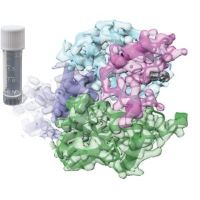Specification
| Description | Recombinant protein from the full-length sequence of homo sapiens fms related tyrosine kinase 1 (FLT1), transcript variant 1 (NM_002019). |
| Organism | Homo sapiens (Human) |
| Expression Host | Human Cells |
| Tag Info | His or DYKDDDDK. Please contact us if you need further information or require specific designed tag. |
| Purity | Greater than 90% by SDS-PAGE gel |
| Uniprot ID | P17948 |
| Entry Name | VGFR1_HUMAN |
| Gene Names | FLT1 FLT FRT VEGFR1 |
| Alternative Gene Names | FLT FRT VEGFR1 |
| Alternative Protein Names | Vascular endothelial growth factor receptor 1 (VEGFR-1) (EC 2.7.10.1) (Fms-like tyrosine kinase 1) (FLT-1) (Tyrosine-protein kinase FRT) (Tyrosine-protein kinase receptor FLT) (FLT) (Vascular permeability factor receptor) |
| Application | Antigens, Western, ELISA and other in vitro binding or in vivo functional assays, and protein-protein interaction studies; For research & development use only! |
| Buffer | Purified protein formulated in a sterile solution of PBS buffer, pH7.2, without any preservatives |
| Endotoxin | Endotoxin level is < 0.1 ng/µg of protein (<1EU /µg) |
| Length | 1338 |
| Molecular Weight(Da) | 150769 |
| Protein Sequence | (The sequence of expressed protein may have some variation from the sequence shown below. Please contact us for the exact sequence.) MVSYWDTGVLLCALLSCLLLTGSSSGSKLKDPELSLKGTQHIMQAGQTLHLQCRGEAAHKWSLPEMVSKESERLSITKSACGRNGKQFCSTLTLNTAQANHTGFYSCKYLAVPTSKKKETESAIYIFISDTGRPFVEMYSEIPEIIHMTEGRELVIPCRVTSPNITVTLKKFPLDTLIPDGKRIIWDSRKGFIISNATYKEIGLLTCEATVNGHLYKTNYLTHRQTNTIIDVQISTPRPVKLLRGHTLVLNCTATTPLNTRVQMTWSYPDEKNKRASVRRRIDQSNSHANIFYSVLTIDKMQNKDKGLYTCRVRSGPSFKSVNTSVHIYDKAFITVKHRKQQVLETVAGKRSYRLSMKVKAFPSPEVVWLKDGLPATEKSARYLTRGYSLIIKDVTEEDAGNYTILLSIKQSNVFKNLTATLIVNVKPQIYEKAVSSFPDPALYPLGSRQILTCTAYGIPQPTIKWFWHPCNHNHSEARCDFCSNNEESFILDADSNMGNRIESITQRMAIIEGKNKMASTLVVADSRISGIYICIASNKVGTVGRNISFYITDVPNGFHVNLEKMPTEGEDLKLSCTVNKFLYRDVTWILLRTVNNRTMHYSISKQKMAITKEHSITLNLTIMNVSLQDSGTYACRARNVYTGEEILQKKEITIRDQEAPYLLRNLSDHTVAISSSTTLDCHANGVPEPQITWFKNNHKIQQEPGIILGPGSSTLFIERVTEEDEGVYHCKATNQKGSVESSAYLTVQGTSDKSNLELITLTCTCVAATLFWLLLTLFIRKMKRSSSEIKTDYLSIIMDPDEVPLDEQCERLPYDASKWEFARERLKLGKSLGRGAFGKVVQASAFGIKKSPTCRTVAVKMLKEGATASEYKALMTELKILTHIGHHLNVVNLLGACTKQGGPLMVIVEYCKYGNLSNYLKSKRDLFFLNKDAALHMEPKKEKMEPGLEQGKKPRLDSVTSSESFASSGFQEDKSLSDVEEEEDSDGFYKEPITMEDLISYSFQVARGMEFLSSRKCIHRDLAARNILLSENNVVKICDFGLARDIYKNPDYVRKGDTRLPLKWMAPESIFDKIYSTKSDVWSYGVLLWEIFSLGGSPYPGVQMDEDFCSRLREGMRMRAPEYSTPEIYQIMLDCWHRDPKERPRFAELVEKLGDLLQANVQQDGKDYIPINAILTGNSGFTYSTPAFSEDFFKESISAPKFNSGSSDDVRYVNAFKFMSLERIKTFEELLPNATSMFDDYQGDSSTLLASPMLKRFTWTDSKPKASLKIDLRVTSKSKESGLSDVSRPSFCHSSCGHVSEGKRRFTYDHAELERKIACCSPPPDYNSVVLYSTPPI |
Background
| Function | FUNCTION: Tyrosine-protein kinase that acts as a cell-surface receptor for VEGFA, VEGFB and PGF, and plays an essential role in the development of embryonic vasculature, the regulation of angiogenesis, cell survival, cell migration, macrophage function, chemotaxis, and cancer cell invasion. Acts as a positive regulator of postnatal retinal hyaloid vessel regression (Ref.11). May play an essential role as a negative regulator of embryonic angiogenesis by inhibiting excessive proliferation of endothelial cells. Can promote endothelial cell proliferation, survival and angiogenesis in adulthood. Its function in promoting cell proliferation seems to be cell-type specific. Promotes PGF-mediated proliferation of endothelial cells, proliferation of some types of cancer cells, but does not promote proliferation of normal fibroblasts (in vitro). Has very high affinity for VEGFA and relatively low protein kinase activity; may function as a negative regulator of VEGFA signaling by limiting the amount of free VEGFA and preventing its binding to KDR. Modulates KDR signaling by forming heterodimers with KDR. Ligand binding leads to the activation of several signaling cascades. Activation of PLCG leads to the production of the cellular signaling molecules diacylglycerol and inositol 1,4,5-trisphosphate and the activation of protein kinase C. Mediates phosphorylation of PIK3R1, the regulatory subunit of phosphatidylinositol 3-kinase, leading to activation of phosphatidylinositol kinase and the downstream signaling pathway. Mediates activation of MAPK1/ERK2, MAPK3/ERK1 and the MAP kinase signaling pathway, as well as of the AKT1 signaling pathway. Phosphorylates SRC and YES1, and may also phosphorylate CBL. Promotes phosphorylation of AKT1 at 'Ser-473'. Promotes phosphorylation of PTK2/FAK1 (PubMed:16685275). {ECO:0000269|PubMed:11141500, ECO:0000269|PubMed:11312102, ECO:0000269|PubMed:11811792, ECO:0000269|PubMed:12796773, ECO:0000269|PubMed:14633857, ECO:0000269|PubMed:15735759, ECO:0000269|PubMed:16685275, ECO:0000269|PubMed:18079407, ECO:0000269|PubMed:18515749, ECO:0000269|PubMed:18583712, ECO:0000269|PubMed:18593464, ECO:0000269|PubMed:20512933, ECO:0000269|PubMed:20551949, ECO:0000269|PubMed:21752276, ECO:0000269|PubMed:7824266, ECO:0000269|PubMed:8248162, ECO:0000269|PubMed:8605350, ECO:0000269|PubMed:9299537, ECO:0000269|Ref.11}.; FUNCTION: [Isoform 1]: Phosphorylates PLCG. {ECO:0000269|PubMed:9299537}.; FUNCTION: [Isoform 2]: May function as decoy receptor for VEGFA. {ECO:0000269|PubMed:21752276}.; FUNCTION: [Isoform 3]: May function as decoy receptor for VEGFA. {ECO:0000269|PubMed:21752276}.; FUNCTION: [Isoform 4]: May function as decoy receptor for VEGFA. {ECO:0000269|PubMed:21752276}.; FUNCTION: [Isoform 7]: Has a truncated kinase domain; it increases phosphorylation of SRC at 'Tyr-418' by unknown means and promotes tumor cell invasion. {ECO:0000269|PubMed:20512933}. |
| Pathway | |
| Protein Families | Protein kinase superfamily, Tyr protein kinase family, CSF-1/PDGF receptor subfamily |
| Tissue Specificity | Detected in normal lung, but also in placenta, liver, kidney, heart and brain tissues. Specifically expressed in most of the vascular endothelial cells, and also expressed in peripheral blood monocytes. Isoform 2 is strongly expressed in placenta. Isoform 3 is expressed in corneal epithelial cells (at protein level). Isoform 3 is expressed in vascular smooth muscle cells (VSMC). {ECO:0000269|PubMed:18515749, ECO:0000269|PubMed:20512933}. |
QC Data
| Note | Please contact us for QC Data |
| Product Image (Reference Only) |  |

